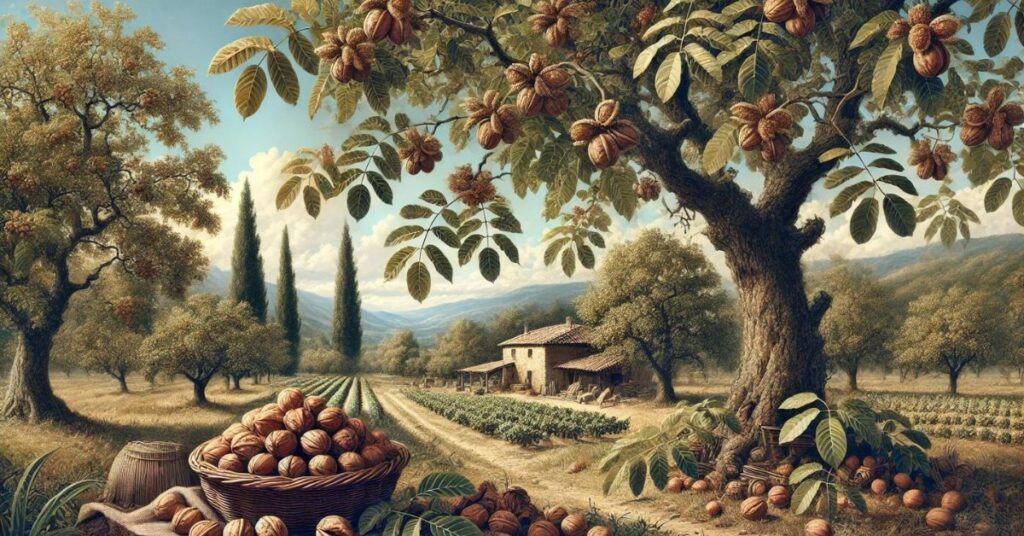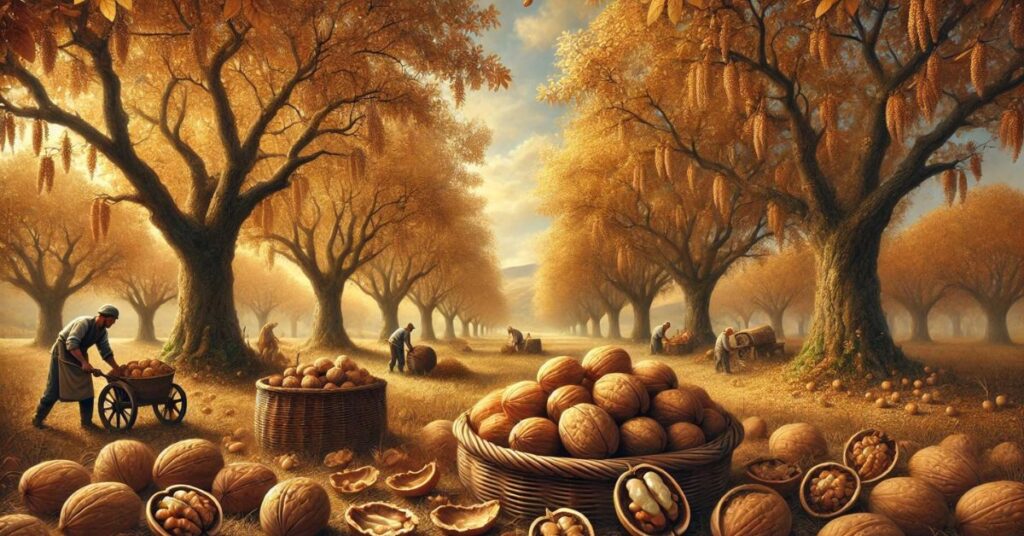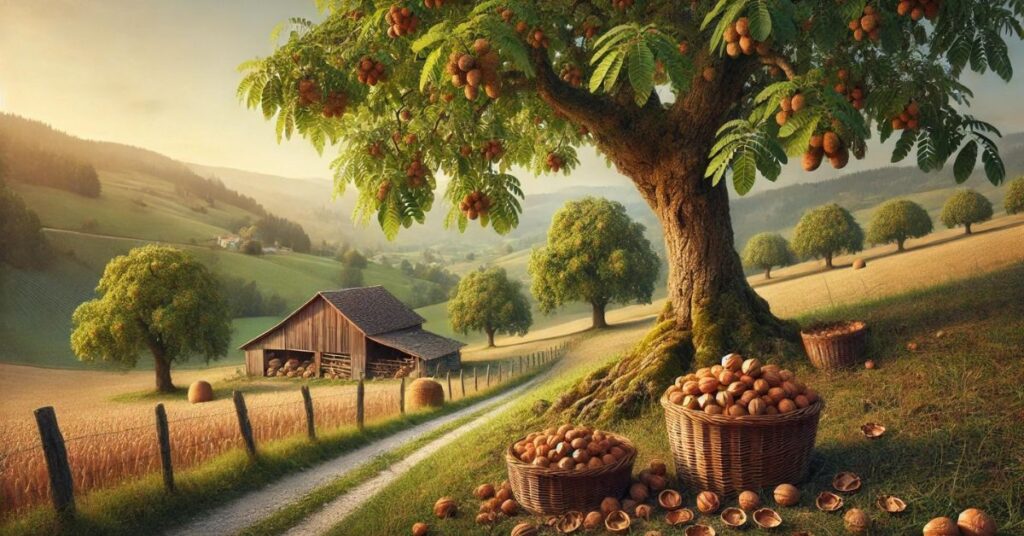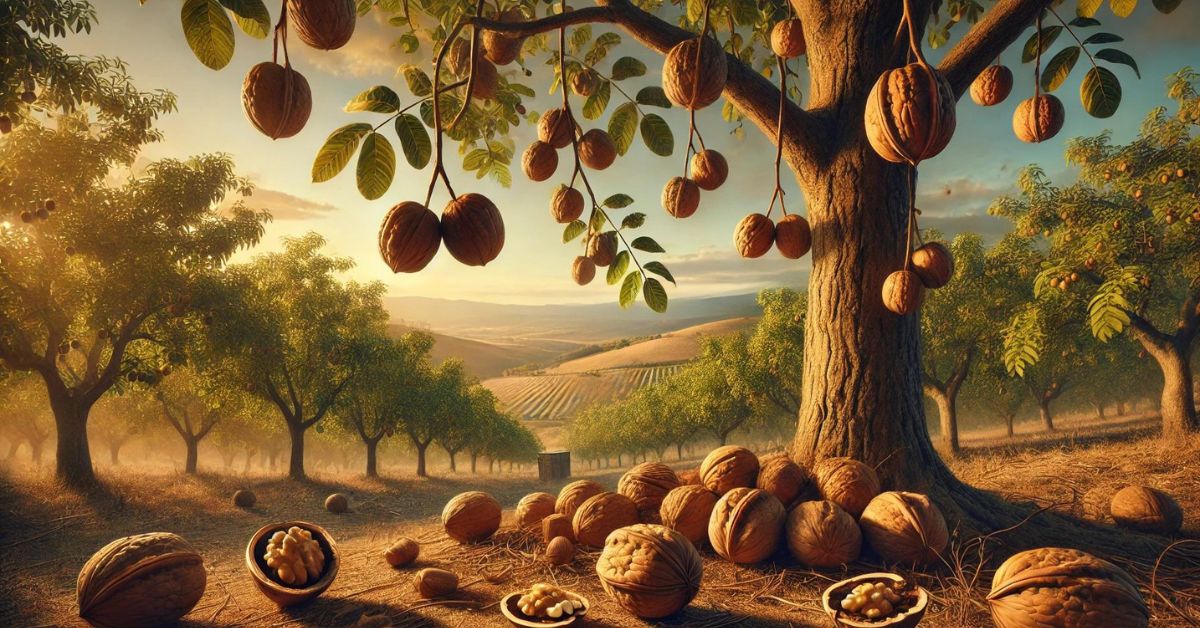The term walnut color is often used to describe a rich, deep shade of brown with warm, earthy tones, reminiscent of the hue of walnut wood. While many people associate walnut color with aesthetics—whether in furniture, flooring, or home décor—it also holds significance in nature and environmental contexts. The color itself is derived from natural sources, including the walnut tree and its fruit, which has historically been used as a natural dye. The walnut tree (genus Juglans) plays an important role in various ecosystems, influencing soil composition, plant diversity, and wildlife interactions.
This article will explore the environmental niche of walnut color, including its ecological origins, the walnut tree’s role in nature, the processes behind the creation of walnut wood and dye, and the broader environmental and cultural significance of this color. We will also examine its role in sustainability and modern ecological design, where walnut color represents more than just a shade, but also a symbol of nature’s richness and ecological balance.
1. The Ecological Origins of Walnut Color
The rich and deep tones associated with walnut color are primarily derived from the walnut tree itself. The walnut tree, known for its hardwood and nutritious fruit, produces nuts that have been a staple food for both wildlife and humans for centuries. The wood of the walnut tree has long been valued for its durability and unique grain, while the walnut fruit produces a natural dye that can be used to create the walnut color in textiles, paints, and other applications.

1.1. The Walnut Tree: A Key Species in Temperate Forests
The walnut tree, particularly the black walnut (Juglans nigra) and the English walnut (Juglans regia), is native to regions across North America, Europe, and parts of Asia. These trees thrive in temperate forests and contribute significantly to the ecosystem.
- Soil Enrichment: Walnut trees are known for their ability to enhance soil composition. They release certain chemicals, like juglone, which can inhibit the growth of competing plant species. This allows the walnut tree to dominate its surroundings, creating a unique microenvironment within the forest.
- Biodiversity Impact: The presence of walnut trees can alter the biodiversity of an area. While juglone can be toxic to some plants, many species have adapted to live in harmony with walnut trees, creating a specialized ecological niche. Wildlife such as squirrels, birds, and insects rely on walnut trees for food and shelter.
1.2. The Role of Walnut Fruit in Dye Production
One of the earliest uses of walnut color comes from the dye produced by the husks of the walnut fruit. When the outer husk of the walnut is crushed, it produces a deep brown dye, which has been used by various cultures throughout history.
- Natural Dye: The dye from walnut husks is a sustainable, eco-friendly alternative to synthetic dyes. Historically, it was used to color textiles, leathers, and even artwork. The resulting walnut color is a warm, natural brown, reflecting the earthiness and complexity of the walnut tree’s ecosystem.
- Cultural Uses: Indigenous peoples and early civilizations used walnut dye for various purposes, including clothing, basket weaving, and even as body paint. The process of extracting the dye is simple and requires minimal processing, making it an accessible resource in the past and an environmentally friendly option today.
2. The Walnut Tree’s Role in the Ecosystem
Walnut trees play an integral role in their ecosystems. Beyond their aesthetic appeal and utilitarian uses, they contribute to environmental balance by influencing soil health, promoting biodiversity, and providing food and shelter for various species.

2.1. Juglone: A Natural Chemical with Ecological Impacts
Walnut trees produce a chemical compound called juglone, which is released into the soil through their roots, leaves, and fruit. Juglone acts as a natural herbicide, inhibiting the growth of certain plants near the walnut tree.
- Allelopathy: The process by which walnut trees release juglone into the environment is called allelopathy. This chemical warfare allows walnut trees to reduce competition from nearby plants, particularly those that are sensitive to juglone, such as tomatoes, peppers, and certain grasses. While juglone can be toxic to some species, others have adapted to thrive in its presence, creating a unique ecological dynamic.
- Soil Health: The presence of juglone can influence the composition of plant species in the area surrounding a walnut tree. This can lead to a specific assemblage of plants and organisms that are either resistant to juglone or able to tolerate its presence, promoting biodiversity in a unique way.
2.2. Wildlife and Walnut Trees
The walnut tree provides food and habitat for a variety of wildlife. The nuts produced by walnut trees are rich in nutrients and serve as a food source for many animals, including birds, squirrels, and other small mammals.
- Nutritional Value of Walnuts: The nuts of the walnut tree are high in fats, proteins, and essential vitamins. For wildlife, this makes walnuts an important food source, especially during the colder months when other food options may be scarce. Squirrels, in particular, are known for gathering and storing walnuts for winter, aiding in the tree’s seed dispersal.
- Habitat and Shelter: In addition to providing food, walnut trees also offer shelter to various species. The dense canopy of the walnut tree provides shade and protection for birds, insects, and other small creatures. The tree’s large branches and deep roots offer nesting sites and burrows, contributing to the survival of numerous species within the ecosystem.
2.3. The Walnut Tree’s Influence on Plant Communities
The growth of walnut trees affects the surrounding plant community by creating a microhabitat that favors certain species over others. The interaction between the walnut tree and nearby plants is a prime example of how one species can shape the ecological niche of an entire area.
- Selective Plant Growth: Because juglone inhibits the growth of some plants, only certain species can survive in the vicinity of walnut trees. This selective pressure leads to a more specialized plant community, with species that have adapted to tolerate or resist the effects of juglone thriving alongside the walnut tree.
- Biodiversity Hotspots: While juglone may reduce the variety of plant species directly beneath a walnut tree, it can create biodiversity hotspots by encouraging the growth of juglone-tolerant plants and fostering a unique ecosystem where specialized species coexist.
3. Human Interaction with Walnut Trees and Walnut Color
For centuries, humans have interacted with walnut trees in various ways. The wood, fruit, and color derived from the walnut tree have been used in construction, art, and everyday life, demonstrating the multifaceted relationship between humans and nature.

3.1. Walnut Wood: A Valuable Resource
Walnut wood is prized for its strength, durability, and rich, dark color. The walnut color of the wood is highly sought after in the production of high-quality furniture, cabinetry, and flooring. Its aesthetic appeal, combined with its physical properties, makes walnut wood a premium material.
- Furniture and Carpentry: Walnut wood is often used in the creation of fine furniture, including tables, chairs, and cabinets. The walnut color adds a sense of warmth and elegance to these pieces, making them highly desirable in interior design. The wood’s durability also ensures that furniture made from walnut can last for generations, contributing to its sustainability.
- Sustainability and Responsible Harvesting: While walnut wood is a valuable resource, it is important to ensure that harvesting practices are sustainable. Overharvesting can lead to deforestation and the loss of critical ecosystems. Many efforts are now in place to promote sustainable forestry, ensuring that walnut trees are replanted and that ecosystems remain intact.
3.2. Walnut Dye: A Natural and Sustainable Coloring Agent
In addition to the wood, the fruit of the walnut tree produces a rich, natural dye that has been used for centuries. The walnut color produced from the dye has been applied to textiles, leather goods, and even artworks, providing a natural alternative to synthetic dyes.
- Traditional Uses of Walnut Dye: Historically, walnut dye was used to color clothing, baskets, and leather. The rich brown hue of the dye made it a popular choice for everyday items, as well as ceremonial garments. The process of creating walnut dye is relatively simple, involving the collection of walnut husks and their boiling to extract the color.
- Eco-Friendly Dyeing: Today, walnut dye is recognized as an environmentally friendly option for coloring textiles. Unlike synthetic dyes, which often involve harmful chemicals and pollutants, walnut dye is biodegradable and non-toxic. As interest in sustainable fashion and eco-friendly materials grows, the use of natural dyes like walnut color is becoming increasingly popular.
3.3. Cultural Significance of Walnut Color
The walnut color has cultural significance in many societies, representing warmth, stability, and a connection to nature. Its deep, earthy tones have been associated with craftsmanship, heritage, and the natural world.
- Symbolism in Art and Design: In art and design, walnut color is often used to convey a sense of tradition and permanence. Its rich tones evoke the warmth of wood and the strength of natural materials, making it a popular choice in interior design, woodworking, and visual arts.
- Connection to Nature: The walnut color is also symbolic of nature’s resilience and beauty. It reflects the deep roots of the walnut tree and its role in ecosystems, as well as humanity’s historical connection to natural materials. As society becomes more aware of environmental issues, the use of walnut color in design and architecture often signals a commitment to sustainability and natural aesthetics.
4. The Role of Walnut Color in Modern Design and Sustainability
In recent years, the environmental significance of walnut color has extended beyond its natural origins to play a role in modern ecological design and sustainability initiatives. As people seek to reconnect with nature and incorporate more environmentally conscious choices into their lives, walnut color has become a symbol of both natural beauty and sustainability.

4.1. Sustainable Interior Design
In interior design, walnut color is prized for its warmth, elegance, and timeless appeal. Designers and architects are increasingly incorporating walnut color into homes and buildings, using materials that reflect the natural tones of walnut wood while prioritizing sustainable practices.
- Eco-Friendly Materials: The use of eco-friendly materials, such as reclaimed walnut wood or sustainably harvested timber, ensures that the beauty of walnut color can be enjoyed without harming the environment. These materials contribute to the aesthetic of the space while supporting responsible forestry and reducing the environmental impact of construction.
- Natural Aesthetics in Architecture: The integration of walnut color into architecture and interior design often reflects a broader movement toward biophilic design, which emphasizes a connection between humans and nature. By incorporating natural colors like walnut, designers aim to create spaces that promote well-being and environmental awareness.
4.2. Walnut Color in Fashion and Textiles
In the fashion industry, the walnut color has seen a resurgence as part of the growing trend toward sustainable and eco-friendly clothing. Natural dyes, including those derived from walnut husks, are increasingly being used to produce fabrics that are both environmentally conscious and visually appealing.
- Sustainable Fashion: As consumers become more aware of the environmental impact of the fashion industry, there is a growing demand for clothing made with natural dyes and sustainable materials. The walnut color produced from walnut dye is a perfect example of this trend, offering a natural, earthy hue that complements eco-friendly fashion.
- Textile Applications: Walnut dye is used to create a range of textile products, from clothing to home décor items. The natural, warm tones of walnut color can be seen in everything from sweaters and scarves to table linens and curtains, reflecting a desire for products that are both stylish and sustainable.
4.3. Walnut Color as a Symbol of Sustainability
Beyond its use in design and fashion, walnut color has become a symbol of sustainability itself. Its deep, earthy tones remind people of the importance of nature, conservation, and responsible stewardship of the environment.
- Connection to Earth: The walnut color evokes a sense of connection to the earth and natural resources. In an era where environmental concerns are at the forefront of global discussions, the use of natural colors like walnut in design and art can serve as a reminder of the beauty and fragility of our planet.
- Promoting Environmental Awareness: Designers, architects, and artists who incorporate walnut color into their work often do so with the intention of promoting environmental awareness. By choosing natural, sustainable materials and colors, they encourage others to consider the environmental impact of their choices and to prioritize sustainability in their own lives.
5. Conservation and the Future of Walnut Trees
As with many natural resources, the future of walnut trees and the availability of walnut color depends on responsible conservation efforts. Overharvesting, deforestation, and climate change all pose threats to walnut tree populations, making conservation initiatives essential for ensuring the sustainability of this valuable species.

5.1. Threats to Walnut Trees
Walnut trees face a number of threats, including habitat loss, disease, and the effects of climate change. Without proper conservation efforts, the health of walnut tree populations could decline, leading to a reduction in the availability of walnut wood, fruit, and the natural walnut color.
- Habitat Loss and Deforestation: The expansion of agriculture and urban development has led to the loss of forests where walnut trees naturally thrive. This not only reduces the number of trees but also disrupts the ecosystems that depend on them.
- Disease and Pests: Walnut trees are susceptible to certain diseases and pests, such as thousand cankers disease, which can cause significant damage to tree populations. Efforts to monitor and control these threats are critical for the preservation of walnut trees.
- Climate Change: Rising temperatures, changing precipitation patterns, and more frequent extreme weather events due to climate change are putting additional stress on walnut trees. These changes can affect the trees’ ability to produce nuts, resist disease, and maintain healthy growth.
5.2. Conservation Efforts for Walnut Trees
To ensure the continued availability of walnut color and the ecological benefits of walnut trees, conservation efforts must focus on protecting and restoring walnut tree populations. This includes sustainable forestry practices, habitat preservation, and research into disease-resistant tree varieties.
- Sustainable Forestry: Implementing sustainable forestry practices is key to protecting walnut tree populations. This involves responsible harvesting, replanting efforts, and careful management of tree populations to prevent overexploitation.
- Habitat Restoration: In areas where walnut trees have been lost due to deforestation, habitat restoration projects can help reestablish healthy walnut tree populations. By planting new trees and protecting existing ones, these projects contribute to the long-term sustainability of walnut forests.
- Research and Innovation: Ongoing research into disease-resistant varieties of walnut trees is essential for combating the threats posed by pests and pathogens. Advances in tree breeding and genetic research can help ensure that future generations of walnut trees remain healthy and productive.
Conclusion: The Ecological and Cultural Importance of Walnut Color
The walnut color represents more than just a shade of brown; it embodies the rich ecological and cultural significance of walnut trees and their role in the environment. From the tree’s contribution to biodiversity and soil health to its use in art, design, and sustainable fashion, walnut color is a symbol of nature’s complexity and beauty.
By understanding the environmental niche of the walnut color and the tree from which it is derived, we can appreciate the importance of protecting these valuable natural resources. Conservation efforts focused on sustainable forestry, habitat restoration, and environmental stewardship are essential for ensuring that future generations can continue to enjoy the benefits of walnut trees and the rich, earthy tones of walnut color.
In a world increasingly focused on sustainability and the responsible use of natural resources, the walnut color serves as a reminder of the enduring connection between humans and the environment. Through thoughtful design, sustainable practices, and a commitment to conservation, we can preserve the beauty and ecological importance of walnut color for generations to come.
Read More: The Lightning Struck Tree: Understanding its Impacts On Environment

